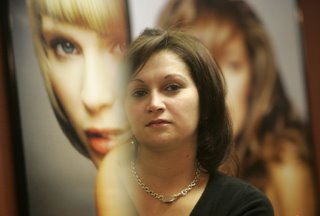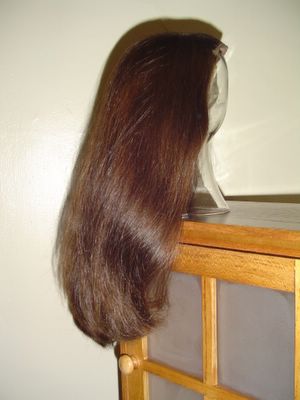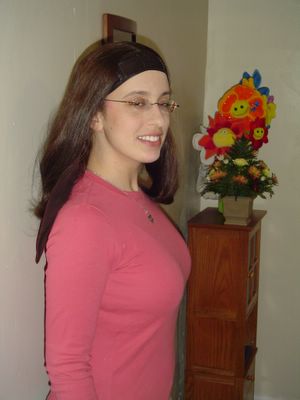
By David Abel | Globe Staff | 12/04/2005
BROOKLINE -- Haircuts always involve a bit of a gamble.
For the women who sit before Sandra Darling, there's often more at stake than their vanity: One errant snip could mean the loss of an investment worth thousands of dollars
"Once you cut it -- that's it," says Darling, her long, slender fingers as important to her as to a surgeon. "It's not growing back."
The 26-year-old hairdresser has built a business in recent years cutting, washing, and styling sheitels -- wigs -- worn by local Orthodox Jewish women, whose religion requires that no man other than their husband sees their natural hair.
The custom, intended for centuries to signify modesty and chastity, has definitely evolved.
The old bushy wigs -- often made of artificial material or coarse horse hair -- have given way in recent decades to the French top, the layered look, and the feathered cut, among others, nearly all fashioned from human hair imported from Europe.
And they're anything but matronly.
They come in all shapes, sizes, colors -- and prices. Orthodox wives can be blondes, brunettes, or redheads, with bangs or curls, wavy or straight hair, though most try to match the color of their natural hair, Darling and others say.
 (Many often have several wigs, for formal occasions, daily chores, and synagogue.) The permutations allow them to affect a short, spiky look, a frumpy and disheveled mop they can connect to hats or headbands, or a long, sultry mane more lustrous than their own hair.
(Many often have several wigs, for formal occasions, daily chores, and synagogue.) The permutations allow them to affect a short, spiky look, a frumpy and disheveled mop they can connect to hats or headbands, or a long, sultry mane more lustrous than their own hair.The elegance and expense of the pieces arguably contradict the tradition's purpose: Darling and Orthodox Jews interviewed say that sometimes they find the women's natural hair less attractive than their wigs.
Women may spend weeks or longer shopping for their wigs before their wedding, and they can cost as much as $5,000, they say. Wigs are now available on websites such as http://www.savvysheitels.com/, which includes adver tisements with come-hither models wearing bright red lipstick.
So when the women visit Darling, who's Catholic and learned only in 2001 about the Orthodox wig tradition, they often know exactly what they want. "They're very to the point -- and they can be stubborn," she says. "A wig might be made to go to the left, and they want it to go to the right. I'll do it their way, but I'll show them it doesn't work."
Over the years, Darling says she has cut more than a hundred wigs and styled thousands of others. She began nearly five years ago when a young brown-haired woman dropped in at her Brookline salon and asked for a trim.
"I just want to let you know it's a wig," the woman announced, recalls Darling, who wasn't sure what to do, but knew that if she messed up it was going to be an expensive mistake. "I had butterflies," she says.
Since then, Darling has learned there are differences between cutting wigs and natural hair. Wigs take about a half-hour longer, she says, and she can charge about twice as much, usually $50 for a cut and $25 for styling. The women require privacy, and she ushers them into a private room in the back of the salon, Crew International on Harvard Street, where they open their carrying cases and remove their wigs from a mannequin's head.
Darling often does three during one appointment, she says, using special clips and an elastic band that stretches from one ear to another. She has to be careful the wig does not fall off her client's head while she's working. Treating the wigs like natural hair, she shampoos them, sets some in curlers, colors others, and blow-dries most when she's done.
The only hairdresser in her salon and one of a few in the area with such a skill, Darling has no need to advertise. "Word gets around very quickly," she says. "They talk in the synagogue, I guess."
The talk sometimes also revolves around whether the women are really required to wear wigs, and what constitutes an appropriate source for them. Last year, after rabbinical authorities in Jerusalem ruled that wigs from India weren't acceptable because they might have been used in Hindu ceremonies -- thus making them potentially idolatrous -- hundreds of Jews in Brooklyn thronged into the streets, piled up the condemned wigs, and torched them.
Before Harvard graduate students Aviva Presser and Erez Lieberman
 married three months ago, the Orthodox Jews discussed whether she would wear a wig. In the end, Presser decided to buy one, but the 24-year-old says she rarely wears it more than once a week, generally only to synagogue. The rest of the time, like others, she wears a hat to cover her hair.
married three months ago, the Orthodox Jews discussed whether she would wear a wig. In the end, Presser decided to buy one, but the 24-year-old says she rarely wears it more than once a week, generally only to synagogue. The rest of the time, like others, she wears a hat to cover her hair."It's way less comfortable than a hat," says Presser, who cut her long, brown wig on her own. "I'm sort of debating and learning more about the practice. It's the Jewish law obligation, but I want to establish whether God cares. If I find it's an invention of people, I guess I'll be less inclined."
Presser dated men who would have ended their relationship immediately had she said she wouldn't cover her hair, she says. In an interview after Shabbat services on a recent Friday night at Young Israel of Brookline, her husband said it's not a big deal for him. "It's entirely up to her," he said.Not all Orthodox husbands have such liberal views.
"I stick to the halakhah," or Jewish law, says Shlomo Amar, who married six months ago. "The hair of a married woman is considered an attractive part of her body and needs to be covered."
He and his wife, Rochelle Amar, also recently attended services at Young Israel, where she was wearing a fashionable wig parted in the middle. The soft, shoulder-length brown hair from Eastern Europe, which required several days to pick out, looked naturally shiny, and matched her eyebrows.
She doesn't like to wear it too often, she says, because she worries it might ruin her natural hair, which most women hide beneath their wigs with the help of barrettes and netting. "That would defeat the purpose," she says. "Then I might not be beautiful for my husband."
Does she think it's potentially hypocritical to wear a wig that some might find attractive?
She's not concerned.
"Just because the law requires modesty," she says, "doesn't mean you have to be ugly."
Her husband says he would object if he thought her wig were too extravagant.
An Orthodox rabbi for eight years whose wife also cuts and styles wigs, Rabbi Yitzchak Rabinowitz of Congregation Beth Israel of Malden says, "There's no question that some women overdo it."
But he also says there's no reason why an Orthodox woman can't look nice, and the mere wearing of a foreign object to cover her "crowning beauty" fulfills her obligation."
According to Jewish law, a woman is not supposed to go around dressed in a provocative manner, where so much of her body is uncovered, like a low-cut dress," he says. "If a woman covers herself properly, is it a contradiction if she wears something attractive to cover herself up? It's not."
It's a sentiment Sandra Darling holds dear.
On a recent afternoon at the salon, with bouncy music in the background, glossy magazines in the waiting area advertising skin-baring celebrities, and Christmas decorations on the walls, Darling says she doesn't question whether her clients should be concerned about primping their wigs.
"Whatever makes them happy," she says.
Not anything goes, though.
"I won't let them look stupid."

David Abel can be reached at dabel@globe.com
Copyright, The Boston Globe

